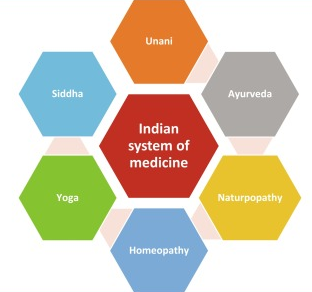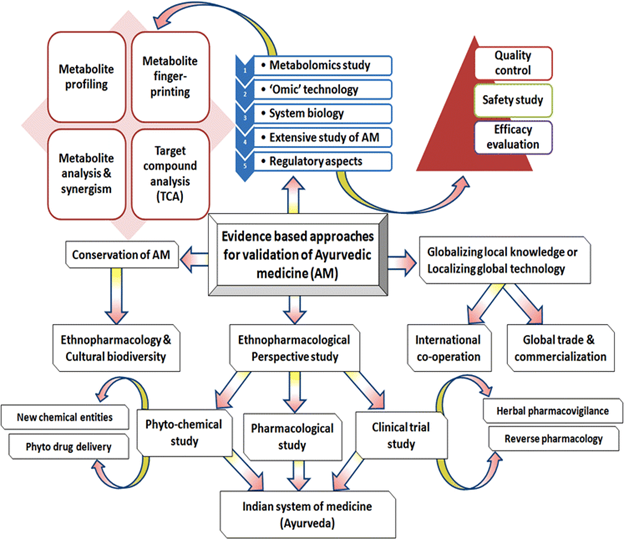We need evidence-based traditional medicine
Relevance
- GS Paper 2 Health, Issues Arising Out of Design & Implementation of Policies, Management of Social Sector/Services.
- Tags: #Traditional Medicine, #Ayurveda, #Modern medicine.
Why in the news?
The case filed by a manufacturer of indigenous drugs against a medical practitioner on the grounds that his social media thread affected their business has become a cause of celebrè in medical circles.
Traditional Medicine
- According to the WHO, traditional medicine is the total sum of the “knowledge, skills and practices indigenous and different cultures have used over time to maintain health and prevent, diagnose and treat physical and mental illness”.
- Its reach encompasses ancient practices such as acupuncture, ayurvedic medicine and herbal mixtures as well as modern medicines.
Traditional Medicine in India
- India stands as a bastion of traditional medicine, offering a mosaic of diverse healing systems. The country boasts six types of traditional medicine, each with its unique philosophy and methodologies.
- These systems are Ayurveda, Siddha, Unani, Yoga, Naturopathy, and Homoeopathy, collectively represented by the Ministry of Ayurveda, Yoga & Naturopathy, Unani, Siddha, and Homoeopathy (AYUSH).
Ayurveda: The Science of Life
- Ayurveda transcends the boundaries of mere healing; it embraces a holistic approach to life.
- Beyond treating illnesses, Ayurveda encompasses social health, mental well-being, environmental harmony, empathy, compassion, and productivity.
- Often referred to as the “knowledge of life,” Ayurveda is celebrated as the fifth Veda, firmly rooted in traditional Indian medicine.
Siddha: The South Indian Heritage
- Siddha, primarily practiced in South India, especially Tamil Nadu, shares a deep affinity with Ayurveda while retaining its distinct identity. It offers unique perspectives on health and healing, contributing to the rich tapestry of traditional Indian medicine.
Unani: A Fusion of Ancient Wisdom
- Unani medicine has a fascinating lineage, with its roots tracing back to Greece, where the legendary physician Hippocrates played a pivotal role.
- The evolution of Unani medicine continued in Egypt and Persia, with contributions from scholars and physicians under Islamic patronage.
- The Unani system was introduced to India around 1350 CE, leaving an indelible mark on its healthcare landscape.
Sowa-Rigpa: Himalayan Healing
- In the Himalayan regions, particularly in Leh-Ladakh, Sowa-Rigpa emerges as a unique traditional medicine system. Practiced in regions such as Sikkim, Arunachal Pradesh, Darjeeling, and Lahaul & Spiti, this system showcases the cultural diversity of traditional medicine in India.
What is the Need to Advance Knowledge of Traditional Medicine?
Traditional Medicine Workers not integrated
- National health systems and strategies do not yet fully integrate traditional medicine workers, accredited courses and health facilities.
Conserving Biodiversity
- There is a need to conserve biodiversity and sustainability as about 40% of approved pharmaceutical products today derive from natural substances.
- For Example: The discovery of aspirin drew on traditional medicine formulations using the bark of the willow tree, the contraceptive pill was developed from the roots of wild yam plants and child cancer treatments have been based on the rosy periwinkle.
Modernization in Studying Traditional Medicine
- The WHO has referred to modernization of the ways traditional medicine is being studied. Artificial intelligence is now used to map evidence and trends in traditional medicine.
- Functional magnetic resonance imaging is used to study brain activity and the relaxation response that is part of some traditional medicine therapies such as meditation and yoga, which are increasingly drawn on for mental health and well-being in stressful times.
Serve as a Hub for Other Countries
- Traditional medicine is also being extensively updated by mobile phone apps, online classes, and other technologies.
- The GCTM will serve as a hub for other countries, and build standards on traditional medicine practices and products.
-
-
Similar Collaborative Efforts taken by India Earlier
Project Collaboration Agreement (PCA)
- In 2016, the Ministry of AYUSH signed a Project Collaboration Agreement (PCA) with the WHO in the area of traditional medicine.
- The aim was to create benchmarks for training in yoga, Ayurveda, Unani and Panchakarma, for traditional medicine practitioners.
- The collaboration also aimed at promoting the quality and safety of traditional medicine and consumer protection by supporting WHO in the development and implementation of the WHO Traditional and Complementary Medicine Strategy.
Related MoUs Signed
- At least 32 MoUs for undertaking collaborative research and development of traditional medicine have been signed with institutes, universities and organizations from the US, Germany, UK, Canada, Malaysia, Brazil, Australia, Austria, Tajikistan, Saudi Arabia, Ecuador, Japan, Indonesia, Reunion Island, Korea and Hungary.
- Also, the Council of Scientific and Industrial Research (CSIR) and the Bill & Melinda Gates Foundation have signed an MoU to identify opportunities for scientific and technological research between researchers within and outside India, including collaborations with foundation-funded entities in the areas including traditional medicine as well as beyond.
-
Modern medicine
- Modern medicine really became science-based only from the late 19th century when advances in technology made not only the study of the functioning of the human body in health and disease more accurate, but also led to safe anaesthesia and surgery.
- Later, this process led to marvels such as dialysis for kidney failure and the heart-lung machine which made surgery on the heart a daily affair.
- It is important to note here that modern medicine is not allopathy (which means “opposed to symptoms”), a term coined by Hahnemann in the 18th century, and used pejoratively, to differentiate it from his newly invented system, homeopathy.
- Modern medicine is western only geographically and not epistemically. Modern medicine, a part of modern science, tests every new therapy and accepts it into the canon if found effective.
- Due to the greater scientific capabilities of the West, which are a result of their richer economies and the post-renaissance historical realities, a great part of modern technology has been developed there, but it is false to think that there is anything epistemically “western” about it.
- One of the great triumphs of the post-World War II phase of human civilization is the greater and quicker flow of ideas across the world.
Ayurveda v/s Modern Medicine
- The physiological basis of Ayurveda is not sound, but that does not ipso facto mean that its therapies are not sound either.
- Like many traditional medical systems everywhere, Ayurveda was constrained in its understanding of how the human body works by the lack of available technology.
- However, the Ayurveda classics were constant in their emphasis on the need to base diagnoses and therapies on a sound understanding of the human body.
- A reason-based world view is what differentiates Ayurveda epistemologically from the erstwhile faith-based forms of the Atharva Veda.
- In modern drug development, the commonly used method is to isolate the active principle. Thus, most modern medicines are single ingredient and only a few are combinations. Also, the exact amount of the active principle is carefully calculated.
- Ayurvedic medicines are commonly combinations, and it is uncertain how these combinations interact with each other.
- It would increase the acceptability of Ayurvedic medicines in the scientific community if they were evaluated by the methods of modern science in a way that does not compromise with the wholeness of Ayurvedic formulations.
Conclusion
- India’s commitment to preserving and advancing traditional medicinal practices is evident through its collaborations with international organizations like the World Health Organization (WHO).
- In 2016, the Ministry of AYUSH entered into a Project Collaboration Agreement (PCA) with the WHO in the area of traditional medicine. Furthermore, numerous Memorandums of Understanding (MoUs) have been signed with institutions worldwide for collaborative research and development of traditional medicinal systems.
- The future holds immense promise for the preservation and expansion of traditional practices. Traditional medicine served as the cradle from which the modern pharmaceutical industry emerged, and safeguarding this knowledge is paramount for future generations.
Source: The Hindu
Mains Question
India’s traditional medicine and way of life hold immense trade and brand potential. Do you agree? Substantiate your views.





